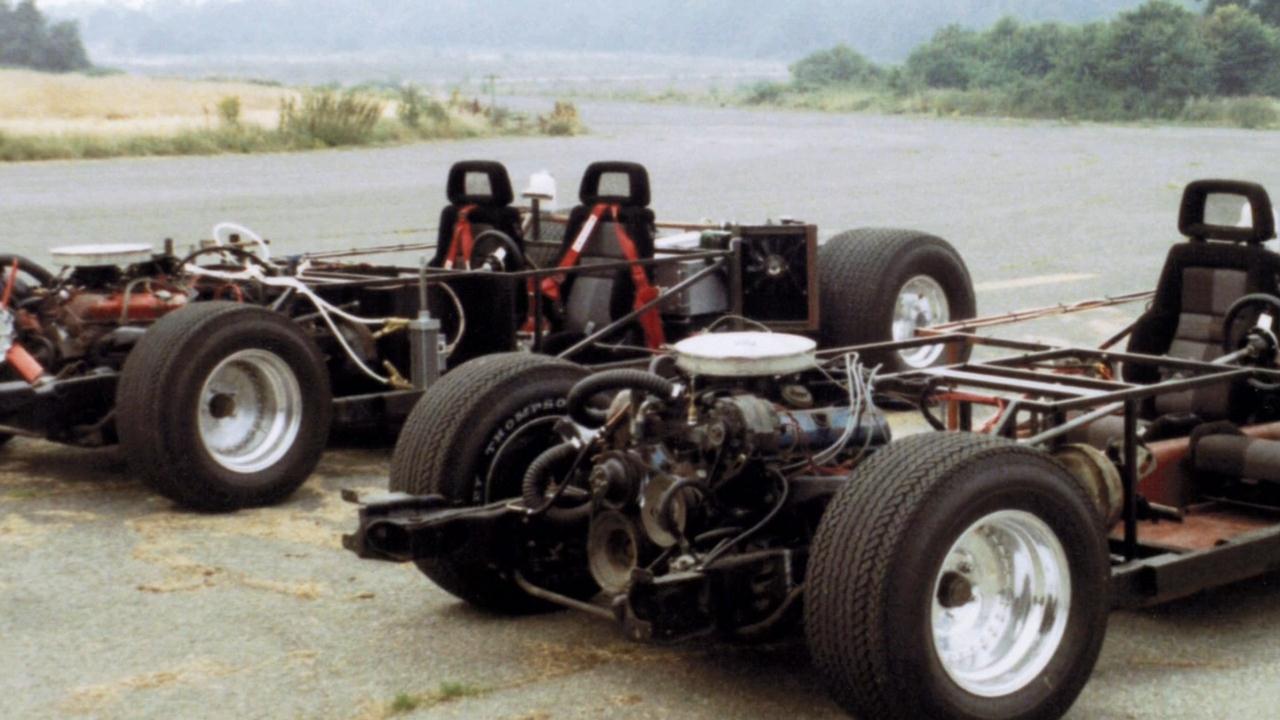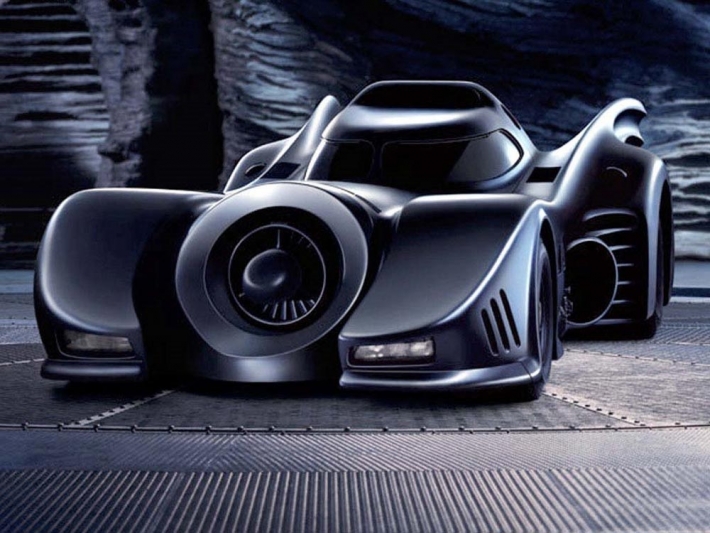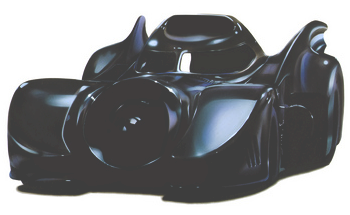I didn't want a futuristic vehicle on a pastiche 1950s car. I went for the most brtual expression of a car, an image which also suggests sex and violence. Anton Furst

Arguably the most popular feature in Batman's arsenal, the batmobile presented the filmmakers with their biggest challenge. The batmobile worried us a lot, " Burton admitted. "Early on, it seemed that everything Anton and I came up with just looked like we were putting fins on cars. Cars can so easily become a joke - people don't realize how difficult it is to make a new kind of car. After a long period of time in which Anton reworked and refined and adjusted the design, we finally hit on something that looked good. Even after the drawing was done, though, we still were not sure how it woud go over in the film. It wasn't until we saw it in rushes that we knew it was right." Envisioning the batmobile as a kind of shining armor for the Dark Knight, Furst designed the vehicle as an extension of Batman himself, "I never really saw the batmobile as just a car." Furst said. "I always thought of it as an appendage to Batman's exterior -- just like his cape or his suit. I was really scared of the idea of it becoming a sort of pimpmobile - you see so many of those low-level concept cars in films. To me, the batmobile was a pure piece of expressionism. I tried to give it that 'knight in armor' look, taking elements of the speed machines from the Utah salt flats of the '40s, the Corvette stingrays of the '50s and combining those elements with jet aircraft components to create one cohesive machine."
Because the batmobile would have to perform in the film as more than just a good-looking prop, Furst had to confer with Evans to ensure that the design was not just visually exciting, but practical as well. "The cars had to function not only as performance cars - with machine guns and afterburners and all that sort of thing laid into them - but also as driving machine." Furst commented. "It takes ten years for General Motors to produce a new car and we had to do this in five months. So I had to design it relatively quickly so that it could get off the drawing board and into the workshops and be ready to shoot. In a way, the batmobile was a more hairy project than building those huge sets. It certainly worried me the most, because it was such an important element of the film. It would have been terrible to come up with a batmobile that was weak."
Though Furst worked furiously to complete the design as quickly as possible, time constraints forced John Evans to begin constructing the batmobile without a finished concept. "We had only twelve weeks to build two batmobiles - one for stunt work and one for principal photography," Evans noted. "But Anton still was not quite happy with the design at that point. So he gave us an outline and we had to go from there. I just could not afford to wait. Because we were so short on time, I felt that I had rather than experiment with to get a chassis that was proven, our own. So I went out and found two 1974 V-8 Chevrolet Impala chassis at a junkyard. They were solid and had nice suspension, We then modified the chassis to fit our specific needs - we lengthened them by two feet, packed the wheels out four inches and dropped the engine about twelve inches.We also put a new suspension in and fitted the chassis with twenty-four-inch-width Mickey Thompson drag racing tires. Then we started from there.It was a tricky period, because we had to go ahead and build it even though we did not have the final measurements and we still did not know exactly what gadgets were going to be included in the car."

While Evans and his crew worked on modifying the Impala chassis, Furst completed the cosmetic aspects of the design. Having found it difficult to render the three-dimensional concept in drawings, the production designer had moved quickly into maquette form. Fashioned out of clay, the maquette was two feet long and six inches high. Set modeler Eddie Butler sculpted the approved rendering up to full-scale - twenty-three feet long and almost nine feet wide - working in high-density polystyrene. The full-scale polystyrene pieces then went to a company that specializes in building Le Mans racing cars to be prepared for molding. "The batmobile was built in kevlar," Furst noted, "which is a polycarbonate that is extremely light and yet very strong. It is the same material used to make racing cars. We then had a custom paint job done on it. There were about six different layers of colors to give the car the finish of a beetle - a lot of colors coming through the blackness so that it had a three-dimensional quality to it rather than being just a flat black. We did not go to a full gloss on it - we left it with a slight matte finish to make it look more like a war machine."

Fitted with interior components from fighter aircraft and an array of military-strength guns and explosives, the batmobile did more than just look like a war machine. "We had two 9mm Browning machine guns which came out of either side on air rams and fired out dummy bullets," Evans explained. "AII of the controls for the guns were actually inside the car. We had speed regulators on them so that they could go at whatever speed the director wanted at the time. The flaps of the car were on compressed air so that they could into the air. There was also a fly up and off about twenty feet grappling hook which fired out of the side which was powered by compressed air and rams. The most difficult thing about all of this was just finding room for all the air cylinders and reservoirs and everything. The inside of the batmobile was very small and it was quite a tight fit just to get everything we needed in there."
Adding to the batmobile's visual allure were rocket engine flames shooting out the back of the car. "That was a tricky situation." Evans noted. "To make it look effective on film, we had to have a lot of flame - which, of course, generated a tremendous amount of heat. We insulated the back of the car and also case we had and we also put Co2 extinguishers in a ring around it, just in case of an accident with the fire. The extinguishers were on a panic button which we put both inside and outside of the car. That way, if the artist got caught inside, he had the capability of employing the extinguishers. The flames were generated with a mixture of gas and air and pyrothane." The only nonfunctional part of the batmobile were the armor shields that open and close at Batman's verbal command. Although the shields were physically incorporated into the vehicle, the opening and closing effect was generated animation.

Depending on the level of danger in a particular shot, the bat- mobile was driven either by Bob Marlais - a member of the Evans effects crew - or a stuntman. "Bob drove it when there were gadgets involved or there was a timing problem for special effects, " explained Evans, "but if it got too dangerous, a stunt- man took over. In some instances where it was crucial that we hit a certain mark at a certain speed, we had to have one of our guys drive it just so the timing was right. One of our first takes - where the batmobile is racing towards the doors of the chemical plant and there are bullet hits going across the door just as the batmobile gets there - was also one of the most difficult. There was only an inch to spare under the bullet hits and the batmobile had to go through there just perfectly. So I had my man drive the car for that sequence and we got it on the first take. That started us off well with the director."
Difficulties notwithstanding, Evans is understandably proud of his automotive achievement. "We managed to deliver two bat mobiles for only about 151,000 pounds - which is not bad. And they were sound automobiles. There were no mechanical break- downs on either car during the entire project. Although the batmobile never went faster than sixty mites per hour in the film, after the picture was finished we took it out on a test track and had it up to 94.7 mites per hour - pretty impressive for a car that was made in our workshop."


